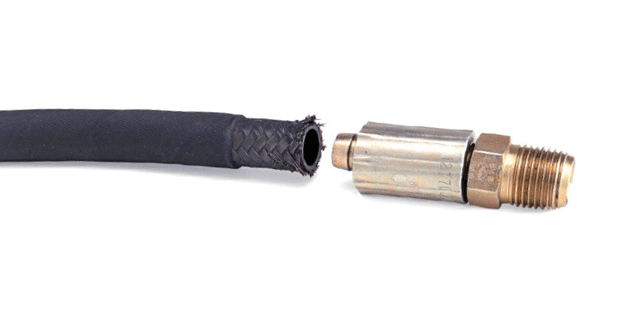
Ways to Improve Life of Hose
Often, one purchases a hose assembly for a hydraulic equipment or system only to experience a premature failure. There are certain parameters which need to be looked at while opting for a hose for an assembly to obtain maximum life for a desired application.
Optimum life of a hose in a particular application is achieved by proper hose selection, safe coupling selection, correctly assemled hose assembly, and safe installation of that assembly. All these points are critical for getting maximum hose life.
Proper hose selection
Proper hose selection is critical to a safe hydraulic system. A simple rule of thumb for proper hose selection is the word ?STAMPED?, (S-size, A-application, T-temperature, M-material, P-pressure, E-ends, D -delivery).
The first step in achieving a safe hydraulic system is selecting correct components that meet your needs. Compromises in components selection, either hose or couplings, may put you in danger, as well as affect the performance and life of your system.
S - Size: The inside diameter of the hose must be adequate to keep pressure loss to minimum and avoid damage to the hose due to heat generation created by excessive turbulence.
T - Temperature: The hose selected must be capable of withstanding the minimum and maximum temperature of the system. Do not expose hose to internal or external temperatures exceeding the recommended limits. An increase of 10?C above the maximum recommended temperature may reduce the hose life by half. Also, hose will crack if flexed at temperatures below the minimum recommended.
A - Application: Select the proper hose for the application. Determine where, or how, the assembly is to be used.
M - Material: Hose selection must assure compatibility of the hose tube, cover, reinforcement, couplings, O-rings, etc, with the fluid used. Many hoses are compatible with one type of fluid or another, but often times not all fluids.
P - Pressure: It is essential in the hose selection process to know the system pressure, including pressure spikes. Published working pressure must be equal to or, greater than the system pressure. Pressure spikes greater than the published working pressure will shorten hose life or lead to hose ruptures
E - Ends: Connecting ends of coupling must be correctly identified.
D - Delivery: How much fluid must go through the hose? This will determine the size of hose that must be used. Under-sizing a hose leads to increased pressure loss, while oversizing the hose adds unnecessary cost, weight and bulk.
Safe coupling selection: It is critical that the hose and coupling manufacturer are the same. Don?t mix and match hose and couplings from various manufacturers. Always use couplings that are recommended by the hose manufacturer for that particular hose. Thread ends must also be compatible in order to prevent leaking or assembly blow off from equipment.
Correct hose assembly: Once the hose and couplings are selected, it is important that the assembly is made properly. If not, the ends could blow off or, the hose may fail at coupling.
Safe hose assembly: It is important that the hose and couplings are from the same manufacturer and they are assembled using the manufacturer?s recommended equipment and procedures. It is critical. Following these recommendations will assure maximum assembly life. If recommended practices are not followed, or hose and couplings from different manufactures are used, there is a significant risk of catastrophic or premature assembly failure.
Hose coupling blow-off
Safe installation: The art of making leak-proof connections with hydraulic couplings is to tighten the couplings properly at the time of installation. An over-tightened (over torque) coupling may be just as apt to leak as an under-tightened coupling. Over-tightening can create a coupling that is overstressed which in turn can lead to cracking and leaks or possibly complete coupling failures. In addition, it is important to pay particular attention to the hose routing. A properly installed hose ensures hazard prevention as well as ensures long life.
Avoid twisted hose installation. A twisted hose installation misaligns the reinforcement (which is the strength imparting component of hose) and reduces its ability to withstand pressure. Twisting a high pressure hose as little as 7o may reduce service life by as much as 90 per cent.
Twist: Avoid positioning hose next to heat sources. Excessive heat may cause hose cover or tube to develop cracks. As explained above, an increase of 10oC above the recommended maximum temperature range may decrease hose life by half. Also, excessive low temperatures beyond recommended limits will create cracks in the cover and/or tube when flexed.
Hose crack: Avoid positioning hose next to metal edges or too close to other hose where any of them or both has movement. The hose cover and reinforcement may be damaged by abrasion, leading to hose failure. This may also lead to safety problem.
The selection process for proper hose and couplings can sometimes seem overwhelming and complicated. When in doubt, it is best to contact your local hose manufacturing representative who can assist in the selection of the best hose and couplings for your application. But, please keep in mind the best value is the hose assembly that gives you the maximum life, not the hose assembly that costs the least.
The author is General Manager Technical, Gates India Pvt Ltd.


 +91-22-24193000
+91-22-24193000 Subscriber@ASAPPinfoGlobal.com
Subscriber@ASAPPinfoGlobal.com